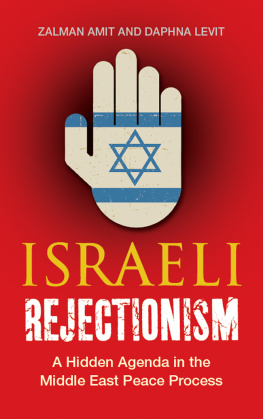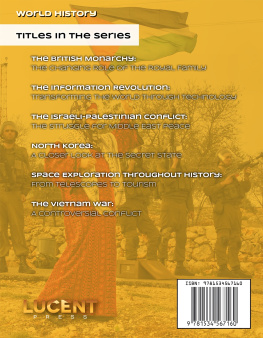First published 2011 by Pluto Press
345 Archway Road, London N6 5AA and
175 Fifth Avenue, New York, NY 10010
Distributed in the United States of America exclusively by Palgrave Macmillan, a division of St. Martins Press LLC, 175 Fifth Avenue, New York, NY 10010
www.plutobooks.com
Copyright Zalman Amit and Daphna Levit 2011
The right of Zalman Amit and Daphna Levit to be identified as the authors of this work has been asserted by them in accordance with the Copyright, Designs and Patents Act 1988.
British Library Cataloguing in Publication Data
A catalogue record for this book is available from the British Library
ISBN 978 0 7453 3029 7 Hardback
ISBN 978 0 7453 3028 0 Paperback
ISBN 978 1 8496 4577 5 PDF eBook
ISBN 978 1 7837 1429 2 Kindle eBook
ISBN 978 1 7837 1428 5 EPUB eBook
Library of Congress Cataloging in Publication Data applied for
This book is printed on paper suitable for recycling and made from fully managed and sustained forest sources. Logging, pulping and manufacturing processes are expected to conform to the environmental standards of the country of origin.
10 9 8 7 6 5 4 3 2 1
Designed and produced for Pluto Press by
Curran Publishing Services, Norwich
Printed and bound in the European Union by
CPI Antony Rowe, Chippenham and Eastbourne
INTRODUCTION
How do two people, one a behavioral neuroscientist and the other a financial analyst, end up joining forces and writing a book about the political history of the Middle East? We were born over a decade apart, our parents or grandparents migrated to Palestine from very different European countries, and our socio-economic backgrounds were quite dissimilar, yet the similarities in our inculcated values and the critical stages of our development are striking.
No matter what part of the world their parents came from, Jews born in the 1930s and 1940s and raised in British Mandatory Palestine, which later became the State of Israel, shared very similar education curricula, belief systems, and even political ideology. The pressure to conform in small communities is always high, but in the Jewish community of the pre-state period it was enormous.
The Jewish community in Palestine during the 1930s and the 1940s consisted of fewer than 500,000 people, barely the size of a small city today. For this community, the authority of the Jewish institutions, whose spokesman was the Jewish Agency, was widely accepted over that of the official British Mandatory government. There were several political parties comprising the Jewish Agency, but its effective blending of political views provided the prescription for a homogeneous upbringing and early indoctrination of the younger generation born in what was commonly called Eretz Israel (the land of Israel).
The majority of the community were non-religious, and most children attended secular schools. There were few differences in the structure of education or the mode of socialization of the pupils in the schools. This uniformity extended to the religious schools as well. A unique feature of the education system was the presence of a parallel, non-academic, and highly political system, the pioneer youth movements. Among the youth movements operating within the mainstream of the Jewish community, two were the largest by far: the socialist youth movement or Labor Youth, under the patronage and supervision of the Histadrut (the Jewish Federation of Labor), and the non-socialist, more centrist movement of the Scouts. The youth movements had an unofficial but powerful affiliation with the school boards, and a comprehensive system of recruitment operated throughout the country effectively until the 1950s and 1960s.
Elementary school principals encouraged their young students to consider joining a youth movement, and would even introduce the representatives of one or other of the movements. Joining was a major rite of passage, and although schools applied no recruitment incentives, the social pressure to join was ferocious. Youth movements operated in practically all towns or villages during the pre-state and the early years of the post-state era.
New members were invited to attend frequent branch activities, which were a mixture of social activities and political indoctrination. The more political meetings were talks given by the counselors, group discussions, or presentations by one of the youths. They invariably focused on the history of the kibbutz movement, of Zionism, and of socialism. The history and geography of the land, and the ties of the Jewish people to it, were foremost in these talks. As the young members grew older, the level and intensity of these activities increased.
Conformity was a crucial value, and extended to many aspects of life. The uniform, for example, was important, and all mainstream youth movements maintained a strict adherence to a dress code. Members attending any activity would dependably wear the uniform shirt, which for both of us at different times was a blue shirt with red laces at the collar. Another youth movement required the same blue shirt but with white laces. One could easily identify fellow members of the group everywhere in the country.
The more dedicated members, with leadership potential, were identified over their first two or three years of membership, and a select few were offered the position of counselor. This was an enormous vote of confidence in their commitment to the movement and their comprehension and knowledge of the movements values, principles, and ideology.
Zalman Amit accepted such an offer, and dedicated a considerable amount of time and effort to the job. Both of us, Zalman as a counselor and Daphna Levit as an ordinary member, were absolutely convinced that we were the vanguard of socialist Zionism serving the neophyte state, and that it relied on our support for its existence.
When the members of a youth movement group who were seriously devoted to its ideals reached their last year of high school, many would traditionally make a commitment to join a specific kibbutz. In the pre-state era they might have established an entirely new kibbutz, and its members would have been expected to join the Haganah, the underground force of the Jewish community, or the Palmach the elite force of the Haganah. The Palmach placed them in specific kibbutzim for one year of service, which was a mixture of military and agricultural training, after which they were invited to apply for membership of the kibbutz.
Soon after the end of the 1948 war, the Palmach was disbanded. Military service at the age of 18 became mandatory, but the disappearance of the Palmach created an enormous problem for the kibbutz movement. It endangered the flow of dedicated, indoctrinated youth committed to the idea of Zionism and its implementation in the framework of a kibbutz. There was serious apprehension that graduates of the pioneering youth movements who would be disconnected from the movement for two years of service in the army would not return to the kibbutz womb.













